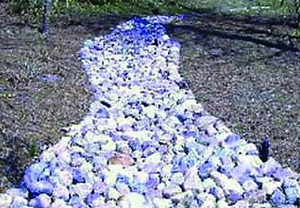
DRAINAGE SYSTEMS

Foundation Drains
Foundation drains divert storm water away from your building’s foundation. Foundation drainpipes are perforated and are usually surrounded by gravel. The pipes disperse the water (instead of discharge in a concentrated area) and the gravel contributes to filtration of the water. The gravel can be wrapped with a layer of filter fabric to prevent the drain from clogging with sediment.

Roof Drainpipes
Roof drainpipes are not perforated and are not connected to the foundation drain system. They should be connected to convey water to the city’s storm drain system to dry well, swell, or directly to a system. (Gutters are completed by the home builder.)

Gutters
Gutters collect runoff from a building’s roof. This runoff is conveyed through downspouts to the roof drain system. Gutters should be kept clear of leaves and other debris so clogging does not occur in the roof drain system. (Completed by the home builder.)

Storms
Storm drainpipes convey rainwater to the city’s storm water system. Storm drainpipes can be made from many different materials such as concrete, aluminum, and polyvinyl chloride (PVC).

Catch Basins
Catch Basins are connected to storm drainpipes. They are concrete structures (either round or rectangular) with metal grates on top. Catch basins capture debris that could clog the pipes in a storm drain system. You can prvent the system from clogging by checking the catch basins in your neighborhood during and after a heavy storm. Use a broom or rake to remove any leaves or debris that have blocked the catch basin's grate. Yard inlets are similar to catch basins but are much smaller and are usually made of metal or plastic.

Trench Drains
Trench drains are used to capture storm water which flows over a large area like a driveway. Trench drains convey water to the city's storm drain system.

French Drains
French drains can be installed anywhere on your property where water collects. French drains are constructed with perforated piping. Gravel and filter fabric surround the piping, similar to a foundation drain system.

Dry Wells
Dry wells can be installed in areas that cannot be connected to a storm water drainage system. Dry wells are filled with gravel and surrounded by filter fabric. Water flows into the wells and filters into the ground through the gravel.

Clean Outs
Clean outs are designed as easy access points for maintenance of the storm water drainage system. They are usually located in a bend where debris can clog the system.


